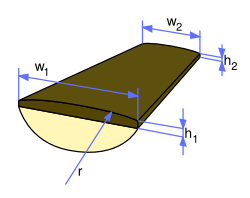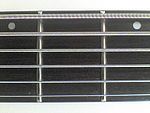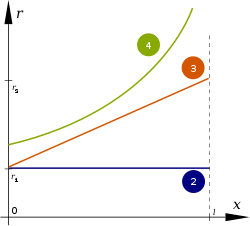- Fingerboard
-
For other uses, see Fingerboard (disambiguation).Fretted guitar fingerboard
 Fretless violin fingerboard
Fretless violin fingerboard
The fingerboard (also known as a fretboard on fretted instruments) is a part of most stringed instruments. It is a thin, long strip of material, usually wood, that is laminated to the front of the neck of an instrument and above which the strings run. In the playing of such an instrument, a musician presses the strings down towards it in order to change their vibrating lengths, causing changes in pitch. This is called "stopping" the strings.
The word "fingerboard" in other languages sometimes occurs in musical directions. In Italian it is called either manico or tasto, the latter especially in the phrase sul tasto, a direction for bowed string instruments to play with the bow above the fingerboard.
Contents
Frets
A fingerboard may be fretted, having raised strips of hard material perpendicular to the strings against which the strings are stopped. Frets easily and consistently allow a musician to stop the string in the same place, and they allow for less damping of the vibrations than fingers alone. Frets may be fixed, as on a guitar or mandolin, or movable, as on a lute. Fingerboards may also be unfretted, as they usually are on bowed instruments, where damping is generally not a problem due to the prolonged stimulation of the strings. Unfretted fingerboards allow a musician more control over subtle changes in pitch than fretted boards, but are generally considered harder to master where intonation is concerned. Fingerboards may also be, though uncommon, a hybrid of these two. Such a construction is seen on the sitar, where arched frets attach at the edges of the fingerboard; unfretted strings run below the frets, while fretted ones run above. The frets are sufficiently high that pressing strings against the fingerboard is unnecessary for the frets to stop their vibrations so that the lower strings' sympathetic vibrations are uninterrupted.
Frets may be marked by inlays to make navigation across the fingerboard easier. On 6-string guitars and bass guitars, the markers are typically single smallish dots marking the 3rd, 5th, 7th and 9th frets, and their octaves higher up the neck, with a double dot or some other variation marking the 12th fret and 24th frets. Variations on the standard dot shape can be used to make a guitar more distinctive. Position markers are sometimes made luminescent (through using paint or replacement with light emitting diodes) to make them more visible on stage. Position markers are also sometimes repeated on the edge of the fretboard for easy viewing.
Over time, frets tend to wear out, resulting in buzzing and "deadness" to the sound of the instrument. This requires a re-fretting job to take place. Not having frets carefully and properly aligned with the fingerboard may result in a severe intonation issue as well as constant detuning. The ultimate way of determining the source of the buzz and detuning problem is to measure the degree to which the frets are level. If you put a straightedge on the neck positioning it so that it is in the "lie" of one of the strings, it would make contact with the top of every fret.
Variation: A variation of the straight fret is the Curved or bent frets that were patented by Andres Thidell of Sweden. The "bending" of the frets allows the plucked strings open pitch to be exactly in tune with that of a fretted note on an entirely different place of the keyboard. In short this system allows the guitar or any other instrument it is used on to play in tune.
This invention has let to several "temperaments" that would otherwise be impossible on a fretted instrument including the Thidell formula 1 as well as the Die Wohltemperirte Gitarr based on what was believed to be J.S. Bach's temperament.
Materials
On bowed string instruments, (such as violin, viola, cello, and double bass), the fingerboard is usually made of ebony, rosewood or some other hardwood. On some guitars a maple neck and fingerboard are made from one piece of wood. A few modern innovative luthiers have used lightweight, non-wood materials such as carbon-fiber in their fingerboards.[1]
Parameters
 Fingerboard profile looking from nut to bridge. Scheme and essential parameters
Fingerboard profile looking from nut to bridge. Scheme and essential parameters
Typically, the fingerboard is a long [plank] with a rectangular profile. On a guitar, mandolin, ukulele, or similar plucked instrument, the fingerboard appears flat and wide, but may be slightly curved to form a cylindrical or conical surface of relatively large radius compared to the fingerboard width. The radius quoted in the specification of a string instrument is the radius of curvature of the fingerboard at the head nut.
Many bowed string instruments use a visibly curved fingerboard, nut and bridge in order to gain bow clearance on each individual string.
The length, width, thickness and density of a fingerboard can affect the timbre of an instrument.
Most fingerboards can be fully described by the following parameters:
- w1 — width at nut (close to headstock);
- w2 — width at half of scale length (if fretted, usually the 12th fret);
- h1 — profile height (thickness) at nut;
- h2 — profile height (thickness) at half of scale length;
- r — radius (may be non-constant);
Radius
Depending on values of radius r and their transition over the length of the fingerboard, all fingerboards usually fit into one of the following four categories:
1 Flat Both nut and bridge are flat. The strings are all in one plane, and the instrument does not have a radius (the radius is in a sense infinite). 
2 Cylindrical The fingerboard has a constant radius, and the fingerboard, the nut and the bridge all have the same nominal radius (that of the fingerboard is strictly speaking a little smaller than that of nut and bridge). r = r1 = r2 = const 3 Conical The fingerboard has a varying radius, usually linearly progressing from r1 to r2. Sometimes it is also called a compound radius.[2] The nut and bridge are both curved but the nut radius is smaller than that of the bridge. 
4 Compound While not strictly conical, with a curved nut and linear bridge. All parts of the fingerboard will have some curvature, but the fingerboard shape is not strictly a cone. r(x) = f(x), usually 
Notes:
- l is a scale.
- x designates a place on fingerboard, changes from 0 (at nut) to l (at bridge).
- r(x) describes radius depending on place on fingerboard.
- f(x) is a non-linear function.
The larger the radius, the flatter the fretboard. Looking down from the headstock, the fingerboard can be seen as a surface section of a larger cylinder. The fret has a slight curve to it, and that arc can be extrapolated to a circle with a center point. The radius is the distance to that point. If you draw a perpendicular line from the middle of the fret to the center point of the theoretical cylinder, you can visualize the outer circle. The fret wire is a section of the circumference of that circle. A 12" radius means the center point is 12 inches from the fret. That’s a smaller circle than one with a 17" radius, and the outside surface of the larger circle is flatter.
Classical guitars, some 12-string guitars, banjos, dobros, pedal steel, and a few steel stringed acoustic guitars have flat fingerboards. Almost all other guitars have at least some curvature. However some recent five and six string electric basses have flat fingerboards.
For guitars, smaller radii (7.25–10") are said to be more comfortable for chord and rhythm playing, while larger radii (12"-16" and up to infinite radius) are more appealing to fast soloing. Conical and compound radius fingerboards try to merge both of these features. The nut end of the fingerboard has a smaller radius towards the nut to ease in forming chords. The bridge end of the fingerboard has a larger radius to make soloing more comfortable and prevent "fretting out" (having the string press against a higher fret during a bend).
A Brief History Of Discovering The Conical Fingerboard in 1978 by luthier Denny Rauen can be found in American Lutherie #8/Winter 1986 and String Instrument Craftsman May/June 1988 under the title "Multi-Radius Fingerboards". This special radiusing is a standard on many of Denny's custom built guitars and refret work beginning in 1978. Articles by Denny Rauen about the "Multi Radius Fingerboard" are the first published documents detailing the initial use of a conical fingerboard for the specific purpose of improving string bending while still retaining the ability for comfortable chording while playing guitar.
Bowed string instruments tend to have curved fingerboards, to allow single strings to be played. Those of the modern violin family and the double bass are strongly curved, however those of some archaic bowed instruments are flat.
Examples
Examples of some instruments' fingerboard radius parameters:
Model r w1 w2 Modern Fender Stratocaster American guitar 9.5" (241 mm)[2] 1 11/16" (42.8 mm) Vintage Fender Stratocaster guitar 7.25" (184.1 mm)[2] Gibson Les Paul guitar 12" (305 mm) 1.68" (43.053 mm) Ibanez guitars Ibanez provide many different radii on their guitars. Their RG and S series have a 400-430 radius fingerboard, meanwhile their artcore have 12" (305mm) Jackson guitars 16" (406 mm)[2] or compound, from 12" (nut) to 16" (heel). A compound radius is common on their newer models Warmoth guitars Compound, from 10" (nut) to 16" (heel)[2] PRS Guitars[3] Regular 10" (254 mm) 1 21/32" (42 mm) 2.25" (57.1 mm) PRS Guitars Wide Fat and Wide Thin 1 11/16" (42.8 mm) 2.25" (57.1 mm) PRS Guitars 513 1 43/64" (42.4 mm) 2 3/16" (55.5 mm) PRS Guitars Hiland 1 21/32" (42 mm) 2 7/32" (56.3 mm) PRS Guitars Santana 11 1/2" (292 mm) 1 21/32” (42 mm) 2.25" (57.1 mm) PRS Guitars Custom 22/12 11 1/2" (292 mm) 1 47/64" (44 mm) 2 19/64" (58.3 mm) Most electric guitars with LSR roller nuts 9.5" to 10" (241 mm to 254 mm)[2] Most electric guitars with Floyd Rose bridge 10" (254 mm)[2] Traditional Classical guitars flat (no radius) Variable by maker Variable by model Martin acoustic guitars 16" (406.4 mm) Variable by model Gibson acoustic guitars 12" (305 mm) Full size (4/4) violin 42 mm 24 mm 40 mm - Radius printable samples
Scalloping
 Scalloped fingerboard of Yngwie Malmsteen Stratocaster
Scalloped fingerboard of Yngwie Malmsteen StratocasterA fretted fingerboard can be scalloped by "scooping out" the wood between each of the frets to create a shallow "U" shape. The result is a playing surface wherein the players' fingers come into contact with the strings only, and do not touch the fingerboard.
The process of "scalloping" a fingerboard well, if done by hand, is tedious work, usually done by careful filing of wood between the frets, and requires a large investment of time. Consequently, it is relatively expensive to have done. Generally scalloping of fingerboards is done by a special milling machine which has 22 or 24 (according to the neck dimensions and number of frets) wood cutting tools. This equipment saves time to the process and dimensional stability like scalloping the wood in the neck's radius same in all fret spaces.
Scalloped fingerboards are most commonly used by shred guitarists, most notably, Yngwie Malmsteen, who, like Ritchie Blackmore (of Deep Purple) uses scalloped fret boards, and had a signature model of Yngwie Malmsteen Stratocaster developed with Fender. Ibanez JEM series guitars, designed and played by Steve Vai, come standard with the last 4 frets scalloped. In 2008 Ibanez made available their E-Gen model, a Herman Li signature, which includes four scalloped frets (21st to 24th). Karl Sanders of the death metal band Nile also uses several guitars with scalloped frets, including several Deans, and KxK Guitars.
In the 1970s, English guitarist John McLaughlin played with Shakti (band), along with Indian violinist L. Shankar, using an acoustic guitar with a fully scalloped fretboard. McLaughlin explained that this feature increased the ease and range of string bends by eliminating friction between finger and fretboard. The scalloped fretboard also made possible the use of rapid, microtonal variation which is so important in Indian music, as exemplified by classical Indian Sitar music.
Experimental luthier Yuri Landman made an electric guitar for John Schmersal of Enon called the Twister with a partial scalloped neck for only the thin strings, (like little playground slides).
Other examples of lutes with scalloped fretboards include the South Indian veena and Vietnamized guitar (called đàn ghi-ta, lục huyền cầm, or ghi-ta phím lõm).The Japanese multi-instrumentalist and experimental musical instrument builder Yuichi Onoue made a deeply scalloped electric guitar for Vietnamese microtonal playing techniques.[4]
Scalloping can be:[5]
- Full, i.e. all frets from the first to the last are scalloped.
- Partial, when some of the top frets are scalloped for fast soloing. Popular examples include half scalloping (12th to the last fret, used by Kiko Loureiro of Angra,[6] among others) or few top frets scalloping (19–24, 17–22, etc.), utilized by such guitarists as Steve Vai. When done by hand, sometimes fretboards can be scalloped half below D or G string, as in the case for Turkish luthier Kenan Turgut.
Note that filing the wood while scalloping also touches inlays, thus fingerboards with complex and intricate inlays usually aren't conducive to scalloping, as it would damage the artwork. Simple dot or block markers survive the procedure well.
Advantages and disadvantages
The "scooped out" nature of scalloped fingerboards creates a number of changes in the way the guitar plays.
Most obvious, is that the fingertip only comes into contact with the string, not the fingerboard itself, creating less friction for bends and vibratos, which results in more overall control while playing.
However, that is also one of the main disadvantages. Many players, especially new players, may find a scalloped fingerboard to be too different to play easily — if the strings are light for the player and/or the player has the tendency to press too hard on the fingerboard, it does take practice to play in tune on a scalloped fingerboard. The player must first become accustomed to not actually touching the fingerboard, which may take some time. Playing a scalloped fingerboard requires a careful application of pressure: too much can change the pitch of the fretted note, as during a bend, and too little pressure can cause fret buzz. As a result, the majority of guitar players choose to use a traditional fingerboard on their instruments.[7]
Scoop of fretless bowed-string fingerboards
Fretless bowed-string fingerboards are usually scooped lengthwise in a smooth curve, so that if a straight edge is held next to the board parallel to a string, some daylight will show between them, towards the centre of the board. Usually the scoop is slightly greater on the bass side, less on the treble side of the fingerboard. Different string materials or different styles of playing may call for differing amounts of scoop; with gut strings requiring the most, and solid steel-core strings the least. A typical full-size (4/4) violin with synthetic-core G, D, and A strings will show 0.75 mm of scoop under the G string, and between 0.5 mm and zero scoop under the E, which generally has a solid steel core on instruments with modern set-up.
On guitars, specifically steel-string and electric guitars, the relief (or "dip") is adjustable by altering the tension on the steel truss rod inside the neck. Relaxing the truss rod allows the pull of the strings to increase the dip, and vice-versa. Classical guitars do not need truss rods due to the lower tension of nylon strings, but should still exhibit some degree of dip.
See also
- Scale (string instruments)
- Fingerboard synthesizer
- Bridge (instrument)
Notes
- ^ Luthier David Rivinus' site explanation of why he doesn't use ebony fingerboards
- ^ a b c d e f g Guitar neck radius article at Warmoth
- ^ PRS Guitars FAQ: What are the differences between necks you offer?
- ^ Yuichi Onoue on hypercustom.com
- ^ Scalloping article at Warmoth
- ^ [1][dead link]
- ^ Ross, Michael (1998). Getting Great Guitar Sounds: A Non-technical Approach to Shaping Your Personal Sound. Hal Leonard Corporation. p. 15. ISBN 9780793591404.
References
- Stringworks U brief description of fingerboard for violins, violas, & cellos
- Violin construction detailed specification sheet by Alan Goldblatt (PDF, 18KB)
- Ibanez website gives specific neck/fingerboard dimensions
- The Scalloped Fretboard Guitar article
- Free professional information about modern luthery (by Stewart MacDonald)
Categories:- String instrument construction
- Guitar parts and accessories
Wikimedia Foundation. 2010.


